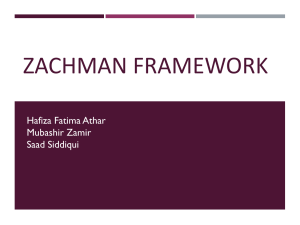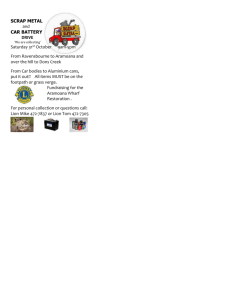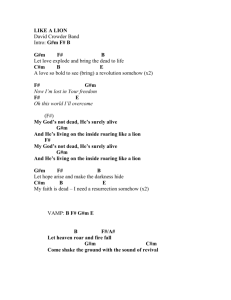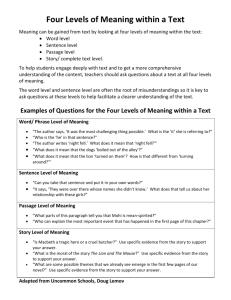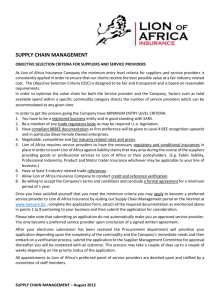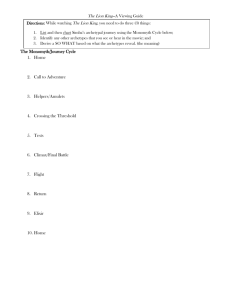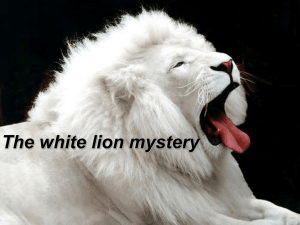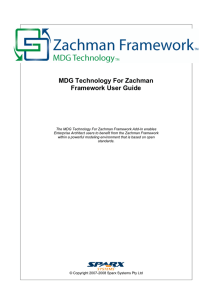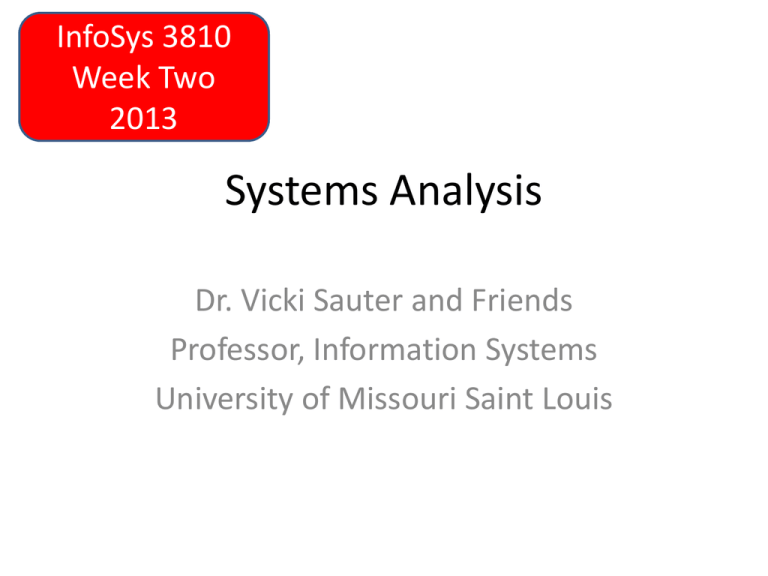
InfoSys 3810
Week Two
2013
Systems Analysis
Dr. Vicki Sauter and Friends
Professor, Information Systems
University of Missouri Saint Louis
Last week
Information Systems Analysis
Systems Analysis and Design is the art
of problem solving.
Systems analysis is the study of a current
business system and its problems, the
determination and definition of business
needs and information requirements, and
the evaluation of alternative solutions.
Last week
Systems Analysis and Design
Systems Analysis … that part of the
software development life cycle that
deals with the study and structure (and
analysis) of information systems
requirements.
Systems Analysis and Design
Five fundamental, separable, yet interrelated
elements
Planning … including requirements elicitation
Analysis
Design (including logical design and physical
design ( or preliminary design and detailed
design)
Implementation … which includes coding, test,
and deployment
And
Maintenance
Systems Analysis and Design
The waterfall model … a sequential
process where one phase is completed
before the next is started …
There is significant formalism to this
model
There is little actual use of this model in
today’s Information Systems world
Systems Analysis and Design
The spiral model … analyze a little,
design a little , code a little, implement
a little … effectively a piecewise
development of requirements and
systems … ideal where requirements
are not fully understood and must be
‘discovered’
Systems Analysis and Design
Modern (aka Agile) methods … including
RAD, JAD, and ExtremeProgramming
are all alternate life cycles with their
own characteristics, strengths,
weaknesses.
Systems Analysis and Design
Structured Methods … pioneered by
Gane and Sarson and Yourdan and
DeMarco are model driven
methodologies
Systems Analysis and Design
Object Oriented Methods … designed
based on the notion that the world can
be represented by a series of objects,
such as data, actions, entities, etc.
Systems Analysis … What
is It?
Systems Analysis … A Definition
Systems Analysis is an explicit formal inquiry
carried out to help someone identify a better
course of action and make a better decision
than he might otherwise have made.
Identification and re-identification) of
objectives, constraints, and alternative
courses of action
Enumeration of the probable consequences
of the alternatives in terms of costs,
benefits, and risks
Presentation of the results in a comparative
framework so that the decision maker can
make an informed choice from among the
alternatives
©
Principia Cybernetica Web
Systems Analysis …
But, What is a System?
Systems and Systems Analysis
Definition of a System
A system is a physical or logical entity
composed of interacting parts that operate
together to achieve some objective or
purpose.
A system is intended to "absorb" inputs,
process them in some way and produce
outputs (where outputs are defined by
goals, objectives or common purposes)
A system may be thought of as and entity
which executes a transformation process
Systems and Systems Analysis
In order to understand the relationship
between inputs, outputs and processes,
you need to understand the environment
in which all of this occurs.
Systems and Systems Analysis
The environment represents everything
that is important to understanding the
functioning of the system, but is not
part of the system. The environment it is
that part of the world that can be
ignored in the analysis except for its
interaction with the system. It includes:
competition, people, technology, capital,
raw materials, data, regulation and
opportunities.
Systems and Systems Analysis
The boundary defines the difference
between the environment and the
system; the correct boundary is a
function of the problem under
consideration.
Some Systems Analysis Fables
The Astronomer
An astronomer used to go out at night to observe the stars. One evening, as he
wandered through the suburbs with his whole attention fixed on the sky, he fell
accidentally into a deep well. While he lamented and bewailed his sores and
bruises, and cried loudly for help, a neighbor ran to the well, and learning what
had happened said: "Hark ye, old fellow, why, in striving to pry into what is in
heaven, do you not manage to see what is on earth?'
Moral: As a system analyst, one should not only pay attention on what are the
perfect standards of a system should be, but also listen and aware of what the
user of the system need and understand the limitation of the system.
These stories are adapted examples written in my class, IS 6840 (formerly MSIS
488).
© Vicki L. Sauter. All rights Reserved.
Some Systems Analysis Fables
A Foolish Man Buys Shoes
In the past there lived a foolish man in a small kingdom called Zheng. One day he wanted to
buy himself a pair of new shoes. He measured his feet with a ruler first and wrote down his
size. But he was in such a hurry to set out that he left it at home. When he arrived at a shoe
shop, he felt in the pocket only to find that it was not there. So he said apologetically, 'I have
left the measurement at home and don't know the size. I'll fetch it in one minute.' With these
words he hurried off as fast as his legs could carry him.
He ran back home, found it and then to the shop again. But still it took him quite a while and
the shop was already closed then. He had gone to all this trouble for nothing and did not get
his shoes.
Then someone asked him, 'Did you buy the shoes for yourself or someone else?' 'For myself, of
course.' he answered. 'Then why don't you try the shoes on by yourself?'
Moral: Do not think the Zheng is so stupid. Nonetheless, we all have such a stupid time. My
point is: System analysis and design is more like art than science. There are no established rules
such as the ¡°measurement of feet¡± in system analysis and design. Thinking creatively and
keep our mind open are very important in the process. In addition to thinking creatively, we
should have customer, supplier, and some other people who may be helpful involve in the
analysis and design phase to ensure that we can look at problems from different angles, not
just close the door make our own “measurement”.
.
Some Systems Analysis Fables
The Lion's Party
A lion was the Kind of a Jungle. He used to organize parties and invited his favorite friends from other species of
animals. To pick his invited friends he used to request services from other animals and judge their performance
arbitrarily without predefined criteria. When he wanted to exclude an animal from the coming party he claimed
that he did not get exactly what he wanted from that animal and that he was not satisfied with the services
provided to him. And he would say: "That's not what I requested" and punished the animal by giving him some
extra work to do without rewarding him and never invited him to the parties. Once he requested from a monkey
to mimic the way a rabbit eats carrots. The poor monkey was trying to mimic how a rabbit eats carrots without
using real carrots. The monkey was arguing that the lion did not say that the monkey has to use real carrots, but
the lion was saying, "I meant that you have to eat carrots the way a rabbit eat it." And the lion punished the
monkey by excluding him from the list of invited animals for the coming party. If the animal manages to perform
well and the lion does not want him to be in the party he changes the formulation of his request and claim that
the animal did not respond exactly to his request. A smart animal was trying hard to overcome the situation and
was thinking of a way to make the lion make his requests clear and make him accept that a third party records
the request and all details related to it, so that the lion won't claim that he was not getting what he requested, if
a given animal manages to respond to the request accurately. First the lion refused to agree to this procedure but
once he find out that this was hurting his reputation and it's giving a bad impression of the way he governs the
jungle he accepted the new procedure and start to go by what it dictates. After the implementation of the new
procedure all animals felt that they were pricked fairly and that there were no discrimination against any of
them. They also worked hard to enhance their performance and go more productive so they can get the
opportunity to go to the lion parties and enjoy being part of the elite invited.
Moral: A software development team might have a well established client that could be tough to deal with
without signed agreements about what is that he wants and expects to get as a system. It's always wise to have
a written and signed agreement that tie the two parties and goes in detail to what the client expects and how he
wants it. The success of the development team would be then measured according to the specifications included
in the agreement and any changes the client might suggest would have to be written and agreed on by the two
parties.
.
Different perspectives
… for different needs
29 / 49
Alternate Perspectives / Alternate
Frameworks
Five alternate frameworks have significant
followings in the business and academic areas
– ARIS
– ZACHMAN
– DoD
– FEA
– TOGAF
© R.A. Navarro
Architecture of Integrated
Information Systems (ARIS)
Process View /
Function View
Data view
Organizational
View
Output View
Control View
Process View
© R.A. Navarro
Zachman Framework, Cont.
A framework for the orderly description
of an enterprise … Created by John
Zachman at IBM / Now in the public
domain
Six Focus Areas
-- What
-- Where
-- When
Six perspectives
-- Planner
-- Designer
-- Subcontractor
-- How
-- Who
-- Why
-- Owner
-- Builder
-- User
© R.A. Navarro
Zachman Framework, Cont.
VA Enterprise
Architecture
DATA
What
FUNCTION
How
NETWORK
Where
PEOPLE
Who
TIME
When
MOTIVATION
Why
SCOPE
(CONTEXTUAL)
Things Im portant
to the Business
Processes
Performed
Business
locations
Important
Organiz ations
Ev ents Signific ant
to the Business
Business Goals
and Strategy
Planner
Entity = Class of
Business Thing
Function = Class of
Business Process
Node = Major
Business Locations
People = Major
Organiz ations
Time = Major
Business Event
Ends/Means =
Major Business Goals
ENTERPRISE
MODEL
(CONCEPTUAL)
Semantic Model
Business Process
Model
Business Logistic s
System
Work Flow Model
Master Schedule
Business Plan
Owner
Ent = Business Entity
Proc = Business Process Node = Business Location People = Organization Unit Time = Business Event
Rel = Business Relationship I/O = Business Resources Link = Business Linkage
Work = Work Product
Cycle = Business Cycle
End = Business Objectiv e
Means = Business Strategy
SYSTEM MODEL
(LOGICAL)
Logical Data
Model
Application
Architecture
Processing
Structure
Business Rule
Model
Designer
Ent = Data Entity
Rel = Data Relationship
Proc = Application Function Node = IS Function
People = Role
I/O = User Views
Link = Line Characteristic s Work = Deliv erable
Time = System Event
Cycle = Processing Cycle
End = Structural Assertion
Means = Action Assertion
TECHNOLOGY
MODEL
(PHYSICAL)
Physical Data
Model
System
Design
Control
Structure
Rule
Design
Builder
Ent = Segment/Table
Rel = Pointer/Key
Proc = Computer Function Node = Hardware/Softw are People = User
I/O = Data Elements /Sets Link = Line Specifications Work = Screen Format
Time = Ex ecute
End = Condition
Cycle = Component Cycle Means = Action
Program
Security
Architecture
Timing
Definition
Rule
Design
Data
DETAILED
REPRESENTATIONS Definition
(OUT-OF-CONTEXT)
Distributed System
Architecture
Technology
Architecture
Netw ork
Architecture
Human Interface
Architecture
Presentation
Architecture
Sub-Contractor
Ent = Field
Rel = Address
Proc = Language Statement Node = Addresses
I/O = Control Block
Link = Protocols
People = Identity
Work = Job
Time = Interrupt
Cycle = Machine Cycle
End = Sub-Condition
Means = Step
FUNCTIONING
ENTERPRISE
Data
Function
Netw ork
Organiz ation
Schedule
Strategy
Ent =
Rel =
Proc =
I/O =
Node =
Link =
People =
Work =
Time =
Cycle =
End =
Means =
DATA
What
FUNCTION
How
NETWORK
Where
© R.A. Navarro
PEOPLE
Who
TIME
When
MOTIVATION
Why
Based on work by
John A. Zachman
SCOPE
(CONTEXTUAL)
Planner
ENTERPRISE
MODEL
(CONCEPTUAL)
Owner
SYSTEM MODEL
(LOGICAL)
Designer
TECHNOLOGY
MODEL
(PHYSICAL)
Builder
DETAILED
REPRESENTATIONS
(OUT-OF-CONTEXT)
Sub-Contractor
FUNCTIONING
ENTERPRISE
Business Rules
A business rule is a rule of a business,
company, or corporation. It is a rule that
defines or constrains some aspect of business
and always resolves to either true or false.
Business rules are intended to assert business
structure or to control or influence the behavior
of the business. Business rules describe the
operations, definitions and constraints that
apply to an organization. Business rules can
apply to people, processes, corporate behavior
and computing systems in an organization, and
are put in place to help the organization
achieve its goals.
Wikipedia.net
Business Rules, Cont.
For example a business rule might state
that no credit check is to be performed
on return customers.
Other examples of business rules include
requiring a rental agent to disallow a
rental tenant if their credit rating is too
low, or requiring company agents to use a
list of preferred suppliers and supply
schedules.
Business Rules, Cont.
A business rule is a statement that defines or constrains
some aspect of the business. It is intended to assert
business structure or to control or influence the behavior
of the business. The business rules that concern the
project are atomic -- that is, they cannot be broken down
further.
For our purposes, this may be viewed from two
perspectives. From the business ('Zachman row-2')
perspective, it pertains to any of the constraints that apply
to the behavior of people in the enterprise, from
restrictions on smoking to procedures for filling out a
purchase order. From the information system ('Zachman
row-3') perspective, it pertains to the facts that are
recorded as data and constraints on changes to the values
of those facts. That is, the concern is what data may, or
may not, be recorded in the information system.
Businessrulesgroup.com
Looking Forward
Identify the business rules associated
with circulation at the UMSL library.
DUE: January 30.
Looking Forward
Do something creative. Document it.
DUE: February 4.
Looking Forward
Write about your thoughts on not-forprofit organizations. In particular, you
need to reflect on why not-for-profit
organizations exist, what different kinds
there are, and their role society. Finally,
discuss any volunteer work you have
done for any kind of not- for-profit
organization.
DUE: February 20.

